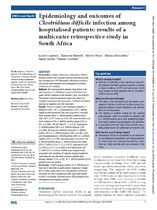| dc.contributor.author | Legenza, Laurel | |
| dc.contributor.author | Barnett, Susanne | |
| dc.contributor.author | Rose, Warren | |
| dc.contributor.author | Bianchini, Monica | |
| dc.contributor.author | Safdar, Nasia | |
| dc.date.accessioned | 2018-07-24T12:17:32Z | |
| dc.date.available | 2018-07-24T12:17:32Z | |
| dc.date.issued | 2018 | |
| dc.identifier.citation | Legenza, L. et al. (2018). Epidemiology and outcomes of Clostridium difficile infection among hospitalised patients: results of a multicentre retrospective study in South Africa. BMJ Glob Health, 3: e000889. | en_US |
| dc.identifier.issn | 2059-7908 | |
| dc.identifier.uri | http://dx.doi.org/10.1136/ bmjgh-2018-000889 | |
| dc.identifier.uri | http://hdl.handle.net/10566/3899 | |
| dc.description.abstract | INTRODUCTION Limited data exist on Clostridium difficile
infection (CDI) in low-resource settings and settings with
high prevalence of HIV. We aimed to determine baseline
CDI patient characteristics and management and their
contribution to mortality.
METHODS We reviewed adult patients hospitalised with
diarrhoea and a C. difficile test result in 2015 from four
public district hospitals in the Western Cape, South Africa.
The primary outcome measures were risk factors for
mortality. Secondary outcomes were C. difficile risk factors
(positive vs negative) and CDI treatment.
RESULTS Charts of patients with diarrhoea tested for C.
difficile (n=250; 112 C. difficile positive, 138 C. difficile
negative) were reviewed. The study population included
more women (65%). C. difficile-positive patients were
older (46.5 vs 40.7 years, p<0.01). All-cause mortality was
more common in the C. difficile-positive group (29% vs
8%, p<0.0001; HR 2.0, 95% CI 1.1 to 3.6). Tuberculosis
(C. difficile positive 54% vs C. difficile negative 32%,
p<0.001), 30-day prior antibiotic exposure (C. difficile
positive 83% vs C. difficile negative 46%, p<0.001) and
prior hospitalisation (C. difficile positive 55% vs C. difficile
negative 22%, p<0.001) were also more common in the
C. difficile-positive group. C. difficile positive test result
(OR 4.7, 95% CI 2.0 to 11.2; p<0.001), male gender (OR
2.8, 95% CI 1.1 to 7.2; p=0.031) and tuberculosis (OR
2.3, 95% CI 1.0 to 5.0; p=0.038) were independently
associated with mortality. Of patients starting treatment,
metronidazole was the most common antimicrobial
therapy initiated (70%, n=78); 32 C. difficile-positive (29%)
patients were not treated.
CONCLUSION Patients testing positive for C. difficile are at
high risk of mortality at public district hospitals in South
Africa. Tuberculosis should be considered an additional
risk factor for CDI in populations with high tuberculosis
and HIV comorbidity. Interventions for CDI prevention and
management are urgently needed. | en_US |
| dc.language.iso | en | en_US |
| dc.publisher | BMJ Publishing Group | en_US |
| dc.rights | This is an open access article distributed in accordance with the
Creative Commons Attribution Non Commercial (CC BY-NC 4.0) license, which
permits others to distribute, remix, adapt, build upon this work non-commercially,
and license their derivative works on different terms, provided the original work is
properly cited, appropriate credit is given, any changes made indicated, and the
use is non-commercial. See:©http:// creativecommons. org/ licenses/ by- nc/ 4. 0/. | |
| dc.subject | Clostridium difficile infection (CDI) | en_US |
| dc.subject | HIV | en_US |
| dc.subject | Hospitalised patients | en_US |
| dc.subject | South Africa | en_US |
| dc.subject | Mortality | en_US |
| dc.title | Epidemiology and outcomes of Clostridium difficile infection among hospitalised patients: results of a multicentre retrospective study in South Africa | en_US |
| dc.type | Article | en_US |
| dc.privacy.showsubmitter | FALSE | |
| dc.status.ispeerreviewed | TRUE | |

